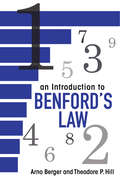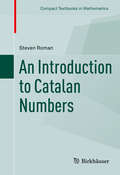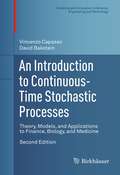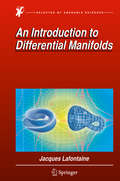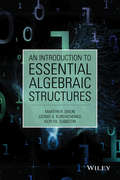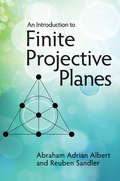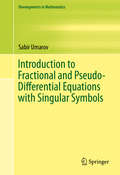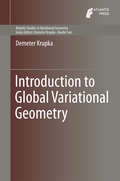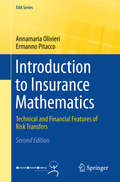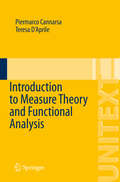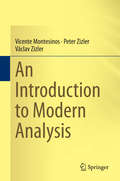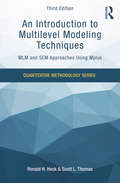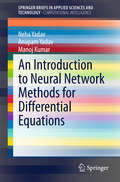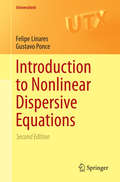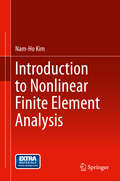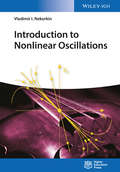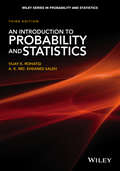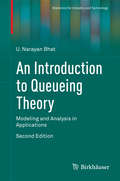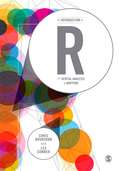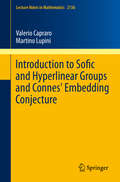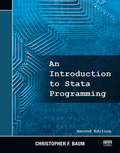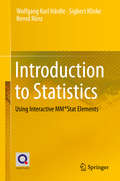- Table View
- List View
An Introduction to Benford's Law
by Arno Berger Theodore P. HillThis book provides the first comprehensive treatment of Benford's law, the surprising logarithmic distribution of significant digits discovered in the late nineteenth century. Establishing the mathematical and statistical principles that underpin this intriguing phenomenon, the text combines up-to-date theoretical results with overviews of the law's colorful history, rapidly growing body of empirical evidence, and wide range of applications.An Introduction to Benford's Law begins with basic facts about significant digits, Benford functions, sequences, and random variables, including tools from the theory of uniform distribution. After introducing the scale-, base-, and sum-invariance characterizations of the law, the book develops the significant-digit properties of both deterministic and stochastic processes, such as iterations of functions, powers of matrices, differential equations, and products, powers, and mixtures of random variables. Two concluding chapters survey the finitely additive theory and the flourishing applications of Benford's law.Carefully selected diagrams, tables, and close to 150 examples illuminate the main concepts throughout. The text includes many open problems, in addition to dozens of new basic theorems and all the main references. A distinguishing feature is the emphasis on the surprising ubiquity and robustness of the significant-digit law. This text can serve as both a primary reference and a basis for seminars and courses.
An Introduction to Catalan Numbers (Compact Textbooks in Mathematics)
by Steven RomanThis textbook provides an introduction to the Catalan numbers and their remarkable properties, along with their various applications in combinatorics. Intended to be accessible to students new to the subject, the book begins with more elementary topics before progressing to more mathematically sophisticated topics. Each chapter focuses on a specific combinatorial object counted by these numbers, including paths, trees, tilings of a staircase, null sums in Zn+1, interval structures, partitions, permutations, semiorders, and more. Exercises are included at the end of book, along with hints and solutions, to help students obtain a better grasp of the material. The text is ideal for undergraduate students studying combinatorics, but will also appeal to anyone with a mathematical background who has an interest in learning about the Catalan numbers. "Roman does an admirable job of providing an introduction to Catalan numbers of a different nature from the previous ones. He has made an excellent choice of topics in order to convey the flavor of Catalan combinatorics. [Readers] will acquire a good feeling for why so many mathematicians are enthralled by the remarkable ubiquity and elegance of Catalan numbers. " - From the foreword by Richard Stanley
An Introduction to Continuous-Time Stochastic Processes: Theory, Models, and Applications to Finance, Biology, and Medicine (Modeling and Simulation in Science, Engineering and Technology)
by Vincenzo Capasso David BaksteinThis textbook, now in its third edition, offers a rigorous and self-contained introduction to the theory of continuous-time stochastic processes, stochastic integrals, and stochastic differential equations. Expertly balancing theory and applications, the work features concrete examples of modeling real-world problems from biology, medicine, industrial applications, finance, and insurance using stochastic methods. No previous knowledge of stochastic processes is required. Key topics include:Markov processesStochastic differential equationsArbitrage-free markets and financial derivativesInsurance riskPopulation dynamics, and epidemicsAgent-based modelsNew to the Third Edition:Infinitely divisible distributionsRandom measuresLevy processesFractional Brownian motionErgodic theoryKarhunen-Loeve expansionAdditional applicationsAdditional exercisesSmoluchowski approximation of Langevin systemsAn Introduction to Continuous-Time Stochastic Processes, Third Edition will be of interest to a broad audience of students, pure and applied mathematicians, and researchers and practitioners in mathematical finance, biomathematics, biotechnology, and engineering. Suitable as a textbook for graduate or undergraduate courses, as well as European Masters courses (according to the two-year-long second cycle of the "Bologna Scheme"), the work may also be used for self-study or as a reference. Prerequisites include knowledge of calculus and some analysis; exposure to probability would be helpful but not required since the necessary fundamentals of measure and integration are provided. From reviews of previous editions:"The book is . . . an account of fundamental concepts as they appear in relevant modern applications and literature. . . . The book addresses three main groups: first, mathematicians working in a different field; second, other scientists and professionals from a business or academic background; third, graduate or advanced undergraduate students of a quantitative subject related to stochastic theory and/or applications. " -Zentralblatt MATH
An Introduction to Differential Manifolds
by Jacques LafontaineThis book is an introduction to differential manifolds. It gives solid preliminaries for more advanced topics: Riemannian manifolds, differential topology, Lie theory. It presupposes little background: the reader is only expected to master basic differential calculus, and a little point-set topology. The book covers the main topics of differential geometry: manifolds, tangent space, vector fields, differential forms, Lie groups, and a few more sophisticated topics such as de Rham cohomology, degree theory and the Gauss-Bonnet theorem for surfaces. Its ambition is to give solid foundations. In particular, the introduction of "abstract" notions such as manifolds or differential forms is motivated via questions and examples from mathematics or theoretical physics. More than 150 exercises, some of them easy and classical, some others more sophisticated, will help the beginner as well as the more expert reader. Solutions are provided for most of them. The book should be of interest to various readers: undergraduate and graduate students for a first contact to differential manifolds, mathematicians from other fields and physicists who wish to acquire some feeling about this beautiful theory. The original French text Introduction aux variétés différentielles has been a best-seller in its category in France for many years. Jacques Lafontaine was successively assistant Professor at Paris Diderot University and Professor at the University of Montpellier, where he is presently emeritus. His main research interests are Riemannian and pseudo-Riemannian geometry, including some aspects of mathematical relativity. Besides his personal research articles, he was involved in several textbooks and research monographs.
An Introduction to Essential Algebraic Structures
by Leonid A. Kurdachenko Martyn R. Dixon Igor Ya SubbotinA reader-friendly introduction to modern algebra with important examples from various areas of mathematicsFeaturing a clear and concise approach, An Introduction to Essential Algebraic Structures presents an integrated approach to basic concepts of modern algebra and highlights topics that play a central role in various branches of mathematics. The authors discuss key topics of abstract and modern algebra including sets, number systems, groups, rings, and fields. The book begins with an exposition of the elements of set theory and moves on to cover the main ideas and branches of abstract algebra. In addition, the book includes:Numerous examples throughout to deepen readers' knowledge of the presented materialAn exercise set after each chapter section in an effort to build a deeper understanding of the subject and improve knowledge retentionHints and answers to select exercises at the end of the bookA supplementary website with an Instructors Solutions manualAn Introduction to Essential Algebraic Structures is an excellent textbook for introductory courses in abstract algebra as well as an ideal reference for anyone who would like to be more familiar with the basic topics of abstract algebra.
An Introduction to Finite Projective Planes (Dover Books on Mathematics)
by Abraham Adrian Albert Reuben SandlerGeared toward both beginning and advanced undergraduate and graduate students, this self-contained treatment offers an elementary approach to finite projective planes. Following a review of the basics of projective geometry, the text examines finite planes, field planes, and coordinates in an arbitrary plane. Additional topics include central collineations and the little Desargues' property, the fundamental theorem, and examples of finite non-Desarguesian planes.Virtually no knowledge or sophistication on the part of the student is assumed, and every algebraic system that arises is defined and discussed as necessary. Many exercises appear throughout the book, offering significant tools for understanding the subject as well as developing the mathematical methods needed for its study. References and a helpful appendix on the Bruck-Ryser theorem conclude the text.
Introduction to Fractional and Pseudo-Differential Equations with Singular Symbols
by Sabir UmarovThe book systematically presents the theories of pseudo-differential operators with symbols singular in dual variables, fractional order derivatives, distributed and variable order fractional derivatives, random walk approximants, and applications of these theories to various initial and multi-point boundary value problems for pseudo-differential equations. Fractional Fokker-Planck-Kolmogorov equations associated with a large class of stochastic processes are presented. A complex version of the theory of pseudo-differential operators with meromorphic symbols based on the recently introduced complex Fourier transform is developed and applied for initial and boundary value problems for systems of complex differential and pseudo-differential equations.
Introduction to Global Variational Geometry
by Demeter KrupkaThe book is devoted to recent research in the global variational theory on smooth manifolds. Its main objective is an extension of the classical variational calculus on Euclidean spaces to (topologically nontrivial) finite-dimensional smooth manifolds; to this purpose the methods of global analysis of differential forms are used. Emphasis is placed on the foundations of the theory of variational functionals on fibered manifolds - relevant geometric structures for variational principles in geometry, physical field theory and higher-order fibered mechanics. The book chapters include: - foundations of jet bundles and analysis of differential forms and vector fields on jet bundles, - the theory of higher-order integral variational functionals for sections of a fibred space, the (global) first variational formula in infinitesimal and integral forms- extremal conditions and the discussion of Noether symmetries and generalizations, - the inverse problems of the calculus of variations of Helmholtz type- variational sequence theory and its consequences for the global inverse problem (cohomology conditions)- examples of variational functionals of mathematical physics. Complete formulations and proofs of all basic assertions are given, based on theorems of global analysis explained in the Appendix
Introduction to Insurance Mathematics
by Annamaria Olivieri Ermanno PitaccoThis second edition expands the first chapters, which focus on the approach to risk management issues discussed in the first edition, to offer readers a better understanding of the risk management process and the relevant quantitative phases. In the following chapters the book examines life insurance, non-life insurance and pension plans, presenting the technical and financial aspects of risk transfers and insurance without the use of complex mathematical tools. The book is written in a comprehensible style making it easily accessible to advanced undergraduate and graduate students in Economics, Business and Finance, as well as undergraduate students in Mathematics who intend starting on an actuarial qualification path. With the systematic inclusion of practical topics, professionals will find this text useful when working in insurance and pension related areas, where investments, risk analysis and financial reporting play a major role.
Introduction to Measure Theory and Functional Analysis
by Piermarco Cannarsa Teresa D'AprileThis book introduces readers to theories that play a crucial role in modern mathematics, such as integration and functional analysis, employing a unifying approach that views these two subjects as being deeply intertwined. This feature is particularly evident in the broad range of problems examined, the solutions of which are often supported by generous hints. If the material is split into two courses, it can be supplemented by additional topics from the third part of the book, such as functions of bounded variation, absolutely continuous functions, and signed measures. This textbook addresses the needs of graduate students in mathematics, who will find the basic material they will need in their future careers, as well as those of researchers, who will appreciate the self-contained exposition which requires no other preliminaries than basic calculus and linear algebra.
Introduction to Model Spaces and their Operators
by Stephan Ramon Garcia Javad Mashreghi William T. RossThe study of model spaces, the closed invariant subspaces of the backward shift operator, is a vast area of research with connections to complex analysis, operator theory and functional analysis. This self-contained text is the ideal introduction for newcomers to the field. It sets out the basic ideas and quickly takes the reader through the history of the subject before ending up at the frontier of mathematical analysis. Open questions point to potential areas of future research, offering plenty of inspiration to graduate students wishing to advance further.
An Introduction to Modern Analysis
by Vicente Montesinos Václav Zizler Peter ZizlerExamining the basic principles in real analysis and their applications, this text provides a self-contained resource for graduate and advanced undergraduate courses. It contains independent chapters aimed at various fields of application, enhanced by highly advanced graphics and results explained and supplemented with practical and theoretical exercises. The presentation of the book is meant to provide natural connections to classical fields of applications such as Fourier analysis or statistics. However, the book also covers modern areas of research, including new and seminal results in the area of functional analysis.
An Introduction to Multilevel Modeling Techniques: MLM and SEM Approaches Using Mplus, Third Edition (Quantitative Methodology Series )
by Ronald H. Heck Scott L. ThomasUnivariate and multivariate multilevel models are used to understand how to design studies and analyze data in this comprehensive text distinguished by its variety of applications from the educational, behavioral, and social sciences. Basic and advanced models are developed from the multilevel regression (MLM) and latent variable (SEM) traditions within one unified analytic framework for investigating hierarchical data. The authors provide examples using each modeling approach and also explore situations where alternative approaches may be more appropriate, given the research goals. Numerous examples and exercises allow readers to test their understanding of the techniques presented. Changes to the new edition include: -The use of Mplus 7.2 for running the analyses including the input and data files at www.routledge.com/9781848725522. -Expanded discussion of MLM and SEM model-building that outlines the steps taken in the process, the relevant Mplus syntax, and tips on how to evaluate the models. -Expanded pedagogical program now with chapter objectives, boldfaced key terms, a glossary, and more tables and graphs to help students better understand key concepts and techniques. -Numerous, varied examples developed throughout which make this book appropriate for use in education, psychology, business, sociology, and the health sciences. -Expanded coverage of missing data problems in MLM using ML estimation and multiple imputation to provide currently-accepted solutions (Ch. 10). -New chapter on three-level univariate and multilevel multivariate MLM models provides greater options for investigating more complex theoretical relationships(Ch.4). -New chapter on MLM and SEM models with categorical outcomes facilitates the specification of multilevel models with observed and latent outcomes (Ch.8). -New chapter on multilevel and longitudinal mixture models provides readers with options for identifying emergent groups in hierarchical data (Ch.9). -New chapter on the utilization of sample weights, power analysis, and missing data provides guidance on technical issues of increasing concern for research publication (Ch.10). Ideal as a text for graduate courses on multilevel, longitudinal, latent variable modeling, multivariate statistics, or advanced quantitative techniques taught in psychology, business, education, health, and sociology, this book’s practical approach also appeals to researchers. Recommended prerequisites are introductory univariate and multivariate statistics.
An Introduction to Neural Network Methods for Differential Equations (SpringerBriefs in Applied Sciences and Technology)
by Manoj Kumar Neha Yadav Anupam YadavThis book introduces a variety of neural network methods for solving differential equations arising in science and engineering. The emphasis is placed on a deep understanding of the neural network techniques, which has been presented in a mostly heuristic and intuitive manner. This approach will enable the reader to understand the working, efficiency and shortcomings of each neural network technique for solving differential equations. The objective of this book is to provide the reader with a sound understanding of the foundations of neural networks and a comprehensive introduction to neural network methods for solving differential equations together with recent developments in the techniques and their applications. The book comprises four major sections. Section I consists of a brief overview of differential equations and the relevant physical problems arising in science and engineering. Section II illustrates the history of neural networks starting from their beginnings in the 1940s through to the renewed interest of the 1980s. A general introduction to neural networks and learning technologies is presented in Section III. This section also includes the description of the multilayer perceptron and its learning methods. In Section IV, the different neural network methods for solving differential equations are introduced, including discussion of the most recent developments in the field. Advanced students and researchers in mathematics, computer science and various disciplines in science and engineering will find this book a valuable reference source.
Introduction to Nonlinear Dispersive Equations
by Felipe Linares Gustavo PonceThis textbook introduces the well-posedness theory for initial-value problems of nonlinear, dispersive partial differential equations, with special focus on two key models, the Korteweg-de Vries equation and the nonlinear Schrödinger equation. A concise and self-contained treatment of background material (the Fourier transform, interpolation theory, Sobolev spaces, and the linear Schrödinger equation) prepares the reader to understand the main topics covered: the initial-value problem for the nonlinear Schrödinger equation and the generalized Korteweg-de Vries equation, properties of their solutions, and a survey of general classes of nonlinear dispersive equations of physical and mathematical significance. Each chapter ends with an expert account of recent developments and open problems, as well as exercises. The final chapter gives a detailed exposition of local well-posedness for the nonlinear Schrödinger equation, taking the reader to the forefront of recent research. The second edition of Introduction to Nonlinear Dispersive Equations builds upon the success of the first edition by the addition of updated material on the main topics, an expanded bibliography, and new exercises. Assuming only basic knowledge of complex analysis and integration theory, this book will enable graduate students and researchers to enter this actively developing field.
Introduction to Nonlinear Finite Element Analysis
by Nam-Ho KimThis book introduces the key concepts of nonlinear finite element analysis procedures. The book explains the fundamental theories of the field and provides instructions on how to apply the concepts to solving practical engineering problems. Instead of covering many nonlinear problems, the book focuses on three representative problems: nonlinear elasticity, elastoplasticity, and contact problems. The book is written independent of any particular software, but tutorials and examples using four commercial programs are included as appendices: ANSYS, NASTRAN, ABAQUS, and MATLAB. In particular, the MATLAB program includes all source codes so that students can develop their own material models, or different algorithms. Please visit the author's website for supplemental material, including PowerPoint presentations and MATLAB codes, at http://www2. mae. ufl. edu/nkim/INFEM/
Introduction to Nonlinear Oscillations
by Vladimir I. NekorkinA systematic outline of the basic theory of oscillations, combining several tools in a single textbook. The author explains fundamental ideas and methods, while equally aiming to teach students the techniques of solving specific (practical) or more complex problems. Following an introduction to fundamental notions and concepts of modern nonlinear dynamics, the text goes on to set out the basics of stability theory, as well as bifurcation theory in one and two-dimensional cases. Foundations of asymptotic methods and the theory of relaxation oscillations are presented, with much attention paid to a method of mappings and its applications. With each chapter including exercises and solutions, including computer problems, this book can be used in courses on oscillation theory for physics and engineering students. It also serves as a good reference for students and scientists in computational neuroscience.
An Introduction to Polynomial and Semi-Algebraic Optimization
by Jean Bernard LasserreThis is the first comprehensive introduction to the powerful moment approach for solving global optimization problems (and some related problems) described by polynomials (and even semi-algebraic functions). In particular, the author explains how to use relatively recent results from real algebraic geometry to provide a systematic numerical scheme for computing the optimal value and global minimizers. Indeed, among other things, powerful positivity certificates from real algebraic geometry allow one to define an appropriate hierarchy of semidefinite (SOS) relaxations or LP relaxations whose optimal values converge to the global minimum. Several extensions to related optimization problems are also described. Graduate students, engineers and researchers entering the field can use this book to understand, experiment with and master this new approach through the simple worked examples provided.
An Introduction to Probability and Statistics
by Vijay K. Rohatgi A.K. Md. SalehA well-balanced introduction to probability theory and mathematical statistics Featuring a comprehensive update, An Introduction to Probability and Statistics, Third Edition remains a solid overview to probability theory and mathematical statistics. Divided into three parts, the Third Edition begins by presenting the fundamentals and foundations of probability. The second part addresses statistical inference, and the remaining chapters focus on special topics. Featuring a substantial revision to include recent developments, An Introduction to Probability and Statistics, Third Edition also includes: A new section on regression analysis to include multiple regression, logistic regression, and Poisson regression A reorganized chapter on large sample theory to emphasize the growing role of asymptotic statistics Additional topical coverage on bootstrapping, estimation procedures, and resampling Discussions on invariance, ancillary statistics, conjugate prior distributions, and invariant confidence intervals Over 550 problems and answers to most problems, as well as 350 worked-out examples and 200 remarks Numerous figures to further illustrate examples and proofs throughout An Introduction to Probability and Statistics, Third Edition is an ideal reference and resource for scientists and engineers in the fields of statistics, mathematics, physics, industrial management, and engineering. The book is also an excellent text for upper-undergraduate and graduate- level students majoring in probability and statistics.
An Introduction to Queueing Theory: Modeling and Analysis in Applications (Statistics for Industry and Technology)
by U. Narayan BhatThis introductory textbook is designed for a one-semester course on queueing theory that does not require a course on stochastic processes as a prerequisite. By integrating the necessary background on stochastic processes with the analysis of models, the work provides a sound foundational introduction to the modeling and analysis of queueing systems for a broad interdisciplinary audience of students in mathematics, statistics, and applied disciplines such as computer science, operations research, and engineering. This edition includes additional topics in methodology and applications. Key features: * An introductory chapter including a historical account of the growth of queueing theory in more than 100 years. * A modeling-based approach with emphasis on identification of models * Rigorous treatment of the foundations of basic models commonly used in applications with appropriate references for advanced topics. * A chapter on matrix-analytic method as an alternative to the traditional methods of analysis of queueing systems. * A comprehensive treatment of statistical inference for queueing systems. * Modeling exercises and review exercises when appropriate. The second edition of An Introduction of Queueing Theory may be used as a textbook by first-year graduate students in fields such as computer science, operations research, industrial and systems engineering, as well as related fields such as manufacturing and communications engineering. Upper-level undergraduate students in mathematics, statistics, and engineering may also use the book in an introductory course on queueing theory. With its rigorous coverage of basic material and extensive bibliography of the queueing literature, the work may also be useful to applied scientists and practitioners as a self-study reference for applications and further research. ". . . This book has brought a freshness and novelty as it deals mainly with modeling and analysis in applications as well as with statistical inference for queueing problems. With his 40 years of valuable experience in teaching and high level research in this subject area, Professor Bhat has been able to achieve what he aimed: to make [the work] somewhat different in content and approach from other books. " - Assam Statistical Review of the first edition
An Introduction to R for Spatial Analysis and Mapping
by Chris Brunsdon Lex Comber"In an age of big data, data journalism and with a wealth of quantitative information around us, it is not enough for students to be taught only 100 year old statistical methods using 'out of the box' software. They need to have 21st-century analytical skills too. This is an excellent and student-friendly text from two of the world leaders in the teaching and development of spatial analysis. It shows clearly why the open source software R is not just an alternative to commercial GIS, it may actually be the better choice for mapping, analysis and for replicable research. Providing practical tips as well as fully working code, this is a practical 'how to' guide ideal for undergraduates as well as those using R for the first time. It will be required reading on my own courses." - Richard Harris, Professor of Quantitative Social Science, University of Bristol R is a powerful open source computing tool that supports geographical analysis and mapping for the many geography and 'non-geography' students and researchers interested in spatial analysis and mapping. This book provides an introduction to the use of R for spatial statistical analysis, geocomputation and the analysis of geographical information for researchers collecting and using data with location attached, largely through increased GPS functionality. Brunsdon and Comber take readers from 'zero to hero' in spatial analysis and mapping through functions they have developed and compiled into R packages. This enables practical R applications in GIS, spatial analyses, spatial statistics, mapping, and web-scraping. Each chapter includes: Example data and commands for exploring it Scripts and coding to exemplify specific functionality Advice for developing greater understanding - through functions such as locator(), View(), and alternative coding to achieve the same ends Self-contained exercises for students to work through Embedded code within the descriptive text. This is a definitive 'how to' that takes students - of any discipline - from coding to actual applications and uses of R.
Introduction to Sofic and Hyperlinear Groups and Connes' Embedding Conjecture
by Valerio Capraro Martino LupiniThis monograph presents some cornerstone results in the study of sofic and hyperlinear groups and the closely related Connes' embedding conjecture. These notions, as well as the proofs of many results, are presented in the framework of model theory for metric structures. This point of view, rarely explicitly adopted in the literature, clarifies the ideas therein, and provides additional tools to attack open problems. Sofic and hyperlinear groups are countable discrete groups that can be suitably approximated by finite symmetric groups and groups of unitary matrices. These deep and fruitful notions, introduced by Gromov and Radulescu, respectively, in the late 1990s, stimulated an impressive amount of research in the last 15 years, touching several seemingly distant areas of mathematics including geometric group theory, operator algebras, dynamical systems, graph theory, and quantum information theory. Several long-standing conjectures, still open for arbitrary groups, are now settled for sofic or hyperlinear groups. The presentation is self-contained and accessible to anyone with a graduate-level mathematical background. In particular, no specific knowledge of logic or model theory is required. The monograph also contains many exercises, to help familiarize the reader with the topics present.
An Introduction To Stata Programming
by Christopher BaumChristopher F. Baum's An Introduction to Stata Programming, Second Edition, is a great reference for anyone that wants to learn Stata programming. For those learning, Baum assumes familiarity with Stata and gradually introduces more advanced programming tools. For the more advanced Stata programmer, the book introduces Stata's Mata programming language and optimization routines. <P><P>This new edition of the book reflects some of the most important statistical tools added since Stata 10, when the book was introduced. Of note are factor variables and operators, the computation of marginal effects, marginal means, and predictive margins using margins, the use of gmm to implement generalized method of moments estimation, and the use of suest for seemingly unrelated estimation. As in the previous edition of the book, Baum steps the reader through the three levels of Stata programming. He starts with do-files. Do-files are powerful batch files that support loops and conditional statements and are ideal to automate your workflow as well as to guarantee reproducibility of your work. <P><P>While giving examples of do-file programming, Baum introduces useful programming tips and advice. He then delves into ado-files, which are used to extend Stata by creating new commands that share the syntax and behavior of official commands. Baum gives an example of how to write a simple additional command for Stata, complete with documentation and certification. After writing the simple command, users can then learn how to write their own custom estimation commands by using both Stata's built-in numerical maximum-likelihood estimation routine, ml, its built-in nonlinear least-squares routines, nl and nlsur, and its built-in generalized method of moments estimation routine. <P><P>Finally, he introduces Mata, Stata's matrix programming language. Mata programs are integrated into ado-files to build a custom estimation routine that is optimized for speed and numerical stability. While discussing Mata, Baum presents useful topics for advanced programming such as structures and pointers and likelihood-function evaluators using Mata. Baum introduces concepts by providing the background and importance for the topic, presents common uses and examples, and then concludes with larger, more applied examples he refers to as "cookbook recipes". <P><P>Many of the examples in the book are of particular interest because they arose from frequently asked questions from Stata users. If you want to understand basic Stata programming or want to write your own routines and commands using advanced Stata tools, Baum's book is a great reference.
Introduction to Statistics
by Wolfgang Karl Härdle Sigbert Klinke Bernd RönzMM*Stat, together with its enhanced online version with interactive examples, offers a flexible tool that facilitates the teaching of basic statistics. It covers all the topics found in introductory descriptive statistics courses, including simple linear regression and time series analysis, the fundamentals of inferential statistics (probability theory, random sampling and estimation theory), and inferential statistics itself (confidence intervals, testing). MM*Stat is also designed to help students rework class material independently and to promote comprehension with the help of additional examples. Each chapter starts with the necessary theoretical background, which is followed by a variety of examples. The core examples are based on the content of the respective chapter, while the advanced examples, designed to deepen students' knowledge, also draw on information and material from previous chapters. The enhanced online version helps students grasp the complexity and the practical relevance of statistical analysis through interactive examples and is suitable for undergraduate and graduate students taking their first statistics courses, as well as for undergraduate students in non-mathematical fields, e. g. economics, the social sciences etc. All R codes and data sets may be downloaded via the quantlet download center
Introduction to Statistics: Using Interactive MM*Stat Elements
by Wolfgang Karl Härdle Sigbert Klinke Bernd RönzThis book covers all the topics found in introductory descriptive statistics courses, including simple linear regression and time series analysis, the fundamentals of inferential statistics (probability theory, random sampling and estimation theory), and inferential statistics itself (confidence intervals, testing).Each chapter starts with the necessary theoretical background, which is followed by a variety of examples. The core examples are based on the content of the respective chapter, while the advanced examples, designed to deepen students’ knowledge, also draw on information and material from previous chapters.The enhanced online version helps students grasp the complexity and the practical relevance of statistical analysis through interactive examples and is suitable for undergraduate and graduate students taking their first statistics courses, as well as for undergraduate students in non-mathematical fields, e.g. economics, the social sciences etc.
